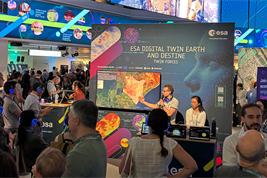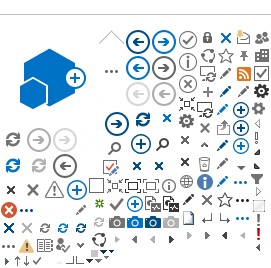29.09.2025

At the ESA Living Planet Symposium 2025, the world’s largest Earth Observation (EO) conference, the Leibniz-Centre for Agricultural Landscape Research (ZALF) presented a wide array of contributions. Held in Vienna from 23 to 27 June 2025 and attended by around 7,000 participants, the event provided an important platform for ZALF researchers to share recent advances from their research on Earth observation-based monitoring, modelling, and decision support for agriculture and land management.
A key focus of ZALF’s contributions was the ZALF-led EOAgriTwin project, Earth Observation based Digital Twin for Resilient Agriculture under Multiple Stressors that integrates earth observation (EO) data and models crop responses to drought, heat, pests, and management practices such as irrigation. Dr. Gohar Ghazaryan presented the project’s concept, current results, and functionalities.
Live demonstrations of EOAgriTwin added an interactive dimension to ZALF’s participation. At the ESA DestinE and Digital Twin Earth booth, Jonas Schreier and Jamina Bondad presented the system’s main functionalities, including dynamic scenario simulations and its modular architecture. The sessions attracted strong interest from attendees exploring how EO-based digital twins can be used in practice.
A key scientific contribution came from Prof. Claas Nendel, who presented on the integration of Earth observation and simulation modelling to evaluate climate adaptation strategies in agriculture. In the session on monitoring and measuring climate adaptation, he outlined how EO-informed models can enhance understanding of crop responses and regional adaptation capacities. His talk also emphasized the reciprocal value of EO data and model outputs in capturing the complexity of agricultural systems, underscoring ZALF’s long-term contribution to process-based modelling and systems analysis.
ZALF researchers also contributed to poster sessions. Lena Krupp presented new work on hydrological dynamics in peatlands using multi-sensor EO data. Olga Wold’s research focused on optimizing agro-ecological models to improve drought resilience, while Dr. Magdalena Main-Knorn demonstrated advances in phenological monitoring through PlanetScope–Sentinel-2 data fusion. The findings on crop-specific drought impact assessments using multi-source EO and modelling were presented by Dr. Esther Shupel Ibrahim. Under the EO Africa National Incubator initiative, results on high-resolution evapotranspiration estimation and drought assessment in Kenya were presented, displaying the work of Dr. S. Mohammad Mirmazloumi and overall ADM-Kenya project.
ZALF’s broad engagement at LPS 2025 reflected its continued investment in developing practical, scalable, and collaborative solutions for land use and agricultural resilience. Across sessions, demonstrations, and collaborative work, the institute highlighted how Earth observation and modelling can be used to address complex challenges in agriculture, both in Europe and globally.
Further information:
Further information on the program can be found on the conference website:
https://lps25.esa.int
Details on the presentations by ZALF researchers can be found here: https://goharghazary.github.io/zalf-lps2025/
